Recent investigations into Mercury, the smallest planet in our Solar System, have led scientists to propose a fascinating new theory about the planet’s internal structure. A team of researchers from institutions in China and Belgium, motivated by updated models of Mercury’s gravity field, have hypothesized that beneath its rocky exterior lies a considerable layer of solid diamonds, potentially up to 18 kilometers thick. This remarkable idea could change our understanding of not only Mercury’s geological history but also the planetary formation processes that resulted in the diverse array of rocky bodies we observe today.
Conventional wisdom suggested that Mercury, orbiting perilously close to our Sun, could not maintain sufficient pressures within its core to synthesize diamonds. However, innovative thermodynamic modeling has opened up new possibilities, indicating a deeper and more pressurized core-mantle boundary than previously recognized. This has sparked renewed enthusiasm among planetary scientists to rethink formative conditions—no longer ignoring the possibility that Mercury’s annihilating heat and pressure might actually facilitate diamond formation in its molten core.
According to the recent study, this diamond formation hinges on several critical factors, including sulfur content and the thermal dynamics of the core itself. Notably, the researchers contend that Mercury’s core could exert enough pressure—akin to 1-2% of conditions found within Earth—to allow carbon to crystallize, resulting in the assumption of a raspy, gem-studded core that slowly worked its way up to the surface over billions of years.
One of the study’s significant findings is related to the mystery surrounding the dark patches across Mercury’s surface. Contrary to previous theories attributing these features to external sources like cometary dust, emerging evidence suggests that they are largely composed of carbon, likely sourced from deep within the planet itself. As carbon crystallized from Mercury’s magma, it ascended, contributing graphite to the planet’s crust, further supporting the notion that Mercury has a rich history of carbon-rich formation.
The implications of this layer of graphite and potential diamonds are profound. Given the nature of carbon—losing its elemental character quickly in the early stages of planetary formation—discovering such richness on Mercury prompts questions about how and when these materials were formed. It necessitates a revision of our understanding of the behaviors and properties of planets that are seemingly unresilient, like this notoriously inhospitable Mercury.
Understanding Mercury’s history becomes even more vital when examining its magnetic field—a unique characteristic among rocky planets. Despite its smaller size and comparatively weaker magnetic field, Mercury’s magnetosphere is a feature that it shares only with Earth, and intriguingly, it may be much older than we expect. Researchers believe that the heat dynamics and properties of materials within Mercury, influenced by diamond’s impressive thermal conductivity, could play a critical role in sustaining this magnetic field over eons.
A comprehensive understanding of what lies beneath Mercury’s exterior is essential, not only for unraveling the mysteries of our solar neighbor but also for shedding light on the formation and evolution of other rocky planets. The potential discovery of diamonds reshapes the conversation around planetary processes, thermodynamics, and the myriad interactions that control a planet’s cooling rates, material movements, and magnetic dynamics.
The revelations about Mercury’s interior may also hold significant implications for exoplanet research. As we continue to discover and study planets orbiting distant stars, understanding the characteristics and evolution of various rocky bodies may lead to better predictions regarding their atmospheres, geology, and magnetic fields. This knowledge could prove crucial in the search for extraterrestrial life and enhancing our grasp of planets outside our own Solar System.
The possibility of a diamond layer beneath Mercury’s surface offers a rich tapestry for scientists to explore and serves as a reminder of the many secrets our solar system still harbors. As research evolves, these insights into Mercury’s compelling history will allow us to not only appreciate its singular characteristics but also extend our understanding of planetary science as a whole.


Leave a Reply